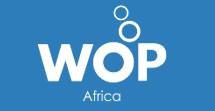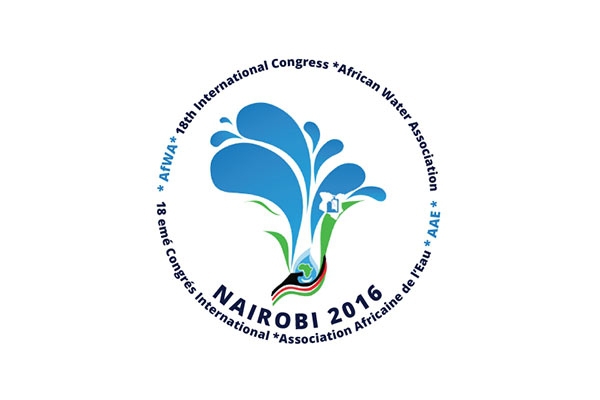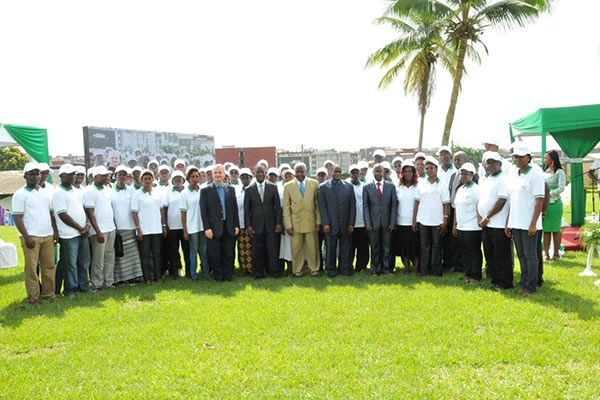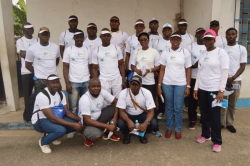AAE / AQUAYA for the water quality test
The Aquaya Institute is a non-profit research and advisory organization specializing in drinking water and sanitation in developing countries. Aquaya was founded in 2005 by academic researchers in the United States. Our mission is to apply the methods and rigor of scientific research to practical field studies, in order to meet the needs of development agencies and actors in the sector. Aquaya has offices in San Francisco (United States) and Nairobi (Kenya).
Since 2012, Aquaya has invested in the Monitoring for Safe Water (MfSW) research program, which aims to promote better water quality monitoring in order to improve its potability. The MfSW program was initiated by a grant from the Bill & Melinda Gates Foundation in Aquaya. The main partners were the African Water Association (AAE / AfWA), the International Water Association (IWA) and the World Health Organization (WHO). More information about the MfSW program is available at: http://www.aquaya.org/project/monitoring-for-safe-water/.
In partnership with the AAE, Aquaya produces summaries summarizing current research on water quality management in Africa.
Summary
The presence of microbes in drinking water is not adequately controlled in sub-Saharan Africa. Click HERE to download
African Academy of Water
The project of the African Water Academy is based in Kampala. She started her first training sessions in February 2010. The aim of this Academy is to develop the leadership of the water supply and sanitation companies and train them in the management of change.
Unbilled Water and Improved Sanitation Services in Sub-Saharan Africa
 Un programmes conçu pour accompagner les sociétés d’eau dans la fourniture de service de qualité, la gestion des infrastructures et l’amélioration de leur gouvernance sur la base de renforcement de capacité entre sociétés d’eau. Ce programme est conjointement financé par l’AAE, l'USAID, la Facilité africaine de l'eau de la Banque africaine de développement (BAD) et UN-HABITAT, pour un montant global d’environ US $3.700.000.
Un programmes conçu pour accompagner les sociétés d’eau dans la fourniture de service de qualité, la gestion des infrastructures et l’amélioration de leur gouvernance sur la base de renforcement de capacité entre sociétés d’eau. Ce programme est conjointement financé par l’AAE, l'USAID, la Facilité africaine de l'eau de la Banque africaine de développement (BAD) et UN-HABITAT, pour un montant global d’environ US $3.700.000.
Young African Water and Sanitation Professionals
The African Water Association was entrusted by AMCOW to the Council of African Ministers of Water, the organization of the Young African Water and Sanitation Professionals in the framework of the implementation of Implementation of its strategy and policy for the integration of youth into the water and sanitation sector in Africa. This program encourages the training of National Committees and monitors their activities to ensure they are active and productive. The EFA, in partnership with USAID / FABRI, has also set up a small grants program of US $ 300,000 for African Young Water and Sanitation Professionals to enable them To contribute to the development of solutions to reduce non-billed water and improve urban sanitation services in Africa.
What is Tunisia desalination production capacity?
Drinking water has at times a bad smelling and a chlorine taste. Is chlorine necessary and...
To ensure sound water disinfection and avoid post contamination while drinking water is stored and distributed, chemicals with residual powers are used. This is the case with the chlorine used in the form of bleach, chlorinated lime, chlorine dioxide or gaseous chlorine. It remains into water because of its residual power and residual products devoted to neutralize any micro-organism that may incidentally get into water pipes.
Drinking water split treatment in any form will therefore be one of the main actions taken to ensure that no biological contamination would arise during distribution through the pipes and thereby confer upon drinking water a fully good microbiological quality.
The level of residual chlorine ranges from 0.1 to 1.2 mg/L. Though detectable, these amounts of chlorine are harm-free to human health. This is so because chlorine elements are totally digested by the stomach. The medicine odor smelt by tap water user is due to chlorine evaporation.
Why was the reverse osmosis employed?
This technique that consists in separating salts from water by means of a semi-permeable membrane under a gradient of pressure was selected following a research and economic report that showed reverse osmosis was the most appropriate approach considering its high level of automation and implementation simplicity. Over the past years, this technique has undergone major developments.
More...
Tunisia is located in a dust bowl, are water resources sufficient enough to ensure sustain...
Tunisia has indeed finite water resources. Her water potential is approximately equal to 5 billions m 3 per annum. The resources that can be mobilized per capita annually account for 465 m 3 and this is deemed by far lower than the poverty line set out by the United Nations Operations - 1000 m 3-. However, Tunisia has proved successful with regard to her resource mobilization policy thanks to a well developed and properly executed integrated management strategy.
This strategy that helped mobilize more than 90 % of resources that could have been mobilized in 2006 is also based on the management of water demand through the establishment of water conservation culture and the development of non conventional resources particularly in the southern Tunisian region.
Tunisia is located in a dust bowl, are water resources sufficient enough to ensure sustain...
Tunisia has indeed finite water resources. Her water potential is approximately equal to 5 billions m 3 per annum. The resources that can be mobilized per capita annually account for 465 m 3 and this is deemed by far lower than the poverty line set out by the United Nations Operations - 1000 m 3-. However, Tunisia has proved successful with regard to her resource mobilization policy thanks to a well developed and properly executed integrated management strategy.
This strategy that helped mobilize more than 90 % of resources that could have been mobilized in 2006 is also based on the management of water demand through the establishment of water conservation culture and the development of non conventional resources particularly in the southern Tunisian region.
Where do air bubbles come from?
Very small air bubbles may appear into water as the pressure drops or temperature rises because solubility in the air has decreased. The play of light is responsible for this typical milk-like appearance. This phenomenon has no impact on water in-built quality.
AfWA / AQUAYA for Water Quality Testing
 The Aquaya Institute (Aquaya) is a non-profit research and consulting organization dedicated to safe drinking water and improved sanitation in developing countries. Aquaya was founded in 2005 by academic researchers in the United States, and our goals are to combine the methods and rigor of peer-reviewed research with practical applied science that supports the needs of development agencies and implementing organizations. Aquaya maintains offices in San Francisco, USA, and Nairobi, Kenya.
The Aquaya Institute (Aquaya) is a non-profit research and consulting organization dedicated to safe drinking water and improved sanitation in developing countries. Aquaya was founded in 2005 by academic researchers in the United States, and our goals are to combine the methods and rigor of peer-reviewed research with practical applied science that supports the needs of development agencies and implementing organizations. Aquaya maintains offices in San Francisco, USA, and Nairobi, Kenya.
Since 2012, Aquaya has been engaged in Monitoring for Safe Water(MfSW), an action research program that promotes drinking water safety through improved monitoring. MfSW was launched with a grant from the Bill & Melinda Gates Foundation to Aquaya. Partners have included the African Water Association (AfWA), the International Water Association (IWA), and the World Health Organization (WHO). More information about MfSW can be found at: http://www.aquaya.org/project/monitoring-for-safe-water/.
Aquaya is collaborating with AfWA to produce research briefs about water quality management in Africa.
Research Brief Drinking water is not sufficiently tested for microbial contamination in sub-Saharan Africa.

 English
English  Français
Français 


